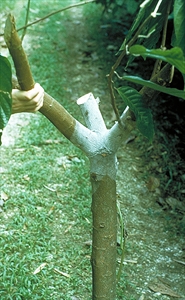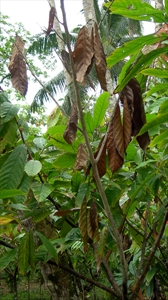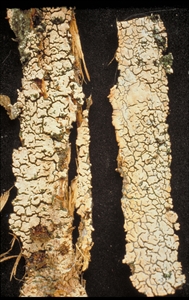- Worldwide distribution. In the tropics. Many trees are hosts, cocoa, Agathis (kauri), citrus, coffee, Cordia, Hibiscus, mango, and many other trees. Usually, a minor disease, unless maintenance is poor.
- White at first, as pustules develop through cracks and natural openings, then pink as spores form. Cankers develop and leaves die and hang down. Spores spread in wind and rain. They can infect through bark.
- Cultural control: use fertile soils and provide adequate nutrition; space trees >3m to aid air circulation; prune infected branches (in dry weather), and cut below the jorquette (top of the trunk where branches develop) allowing regrowth; avoid heavy shade.
- Chemical control: collect and burn pruned branches; apply copper fungicide as a paste to cut end.
Pacific Pests, Pathogens and Weeds - Online edition
Pacific Pests, Pathogens, Weeds & Pesticides
Cocoa pink disease (012)
Pink disease of cocoa
Erythricum salmonicolor; also known by older names, Phanerochaete salmonicolor, and Corticium salmonicolor.
AUTHORS Helen Tsatsia & Grahame Jackson
Information from CABI (2019) Erythricium salmonicolor (pink disease). Crop Protection Compendium. (https://www.cabi.org/cpc/datasheet/15454. Photo 3 Kohler F, et al. (1997) Diseases of cultivated crops in Pacific Island countries. South Pacific Commission. Pirie Printers Pty Limited, Canberra, Australia.
Produced with support from the Australian Centre for International Agricultural Research under project PC/2010/090: Strengthening integrated crop management research in the Pacific Islands in support of sustainable intensification of high-value crop production, implemented by the University of Queensland and the Secretariat of the Pacific Community.






